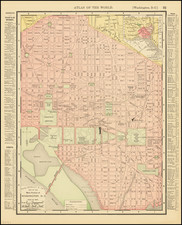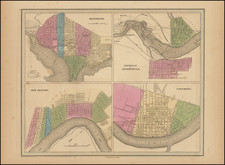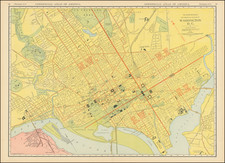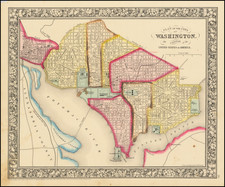A very fine and rare engraved elevation view of the United States Capitol Building. Drawn by British architect Charles Busby during its restoration following the burning of Washington during the War of 1812.
Busby’s view depicts the façade of the Capitol as seen from the East. Other than the symmetrical north (Senate) and south (House) wings flanking a central neoclassical portico, it is barely recognizable as the core of the modern Capitol. The central monumental steps were added later in the 1820s, while the soaring dome and north and south extensions were not added until the 1850s-60s, yielding the structure we are familiar with today.
Background
The original design for the Capitol was submitted in 1793, not by an American, but by William Thornton, a Scottish physician living in Tortola. It called for a central hall capped by a low dome and flanked north and south by two rectangular wings. Construction proceeded slowly, and when the War of 1812 broke out the south wing was complete, the north wing partially so, and the two connected by little more than a wooden passageway. Construction was halted by the War, and the wings were all-but destroyed by fire during the British occupation of Washington in August 1814. For the next several years Congress was forced to meet in a building on the site of what is now the U.S. Supreme Court.
In 1815 Benjamin Latrobe, who had overseen much of the pre-War construction, was appointed to oversee the Capitol’s restoration and completion.
Latrobe returned to Washington in 1815, when he was rehired to restore the U.S. Capitol Building. In addition to making repairs, he took advantage of this opportunity to make further changes in the building’s interior design (for example, an enlargement of the Senate Chamber) and introduce new materials (for example, marble discovered along the upper Potomac). However, he came under increasing pressure because of construction delays (most of which were beyond his control) and cost overruns. He resigned his post in November 1817.
On January 8, 1818, Charles Bullfinch, a prominent Boston architect, was appointed Latrobe’s successor. Continuing the restoration of the north and south wings, he was able to make the chambers for the Supreme Court, the House, and the Senate ready for use by 1819. Bulfinch also redesigned and supervised the construction of the Capitol Building’s central section…. After completing the last part of the building in 1826, Bullfinch spent the next few years on the Capitol's decoration and landscaping. In 1829, his work was done and his position with the government was terminated. (“History of the U.S. Capitol Building” on the website of the Architect of the Capitol)
After the project’s completion, the Capitol looked very much as it does in Busby’s view, though by 1826 Latrobe had added the central monumental staircase still visible today on the east façade. It was only in the 1850s and 1860s that the steady growth of the Federal Government necessitated the addition of wings to the north and south, bringing the Capitol’s footprint to what it is today. As a result of his expansion, the low dome constructed by Bullfinch was inadequate to the building’s massive proportions, and it was replaced by a vast, colonnaded dome that today dominates the Washington, D.C. skyline.
Charles Augstin Busby
The view was drawn, engraved and published by British architect and engineer Charles Busby (1786-1834). Busby began exhibiting at the Royal Academy from 1801, and in 1808 he published the well-received A Series of Designs for Villas and Country Houses and A Collection of Designs for Modern Embellishments. Several serious commissions followed, including one for a Gothic castle at Gwrych, Denbighshire. The project did not go well, however, and after losing the commission he left for the United States, where he spent much of the years 1817-1819. He must have spent time in New York City, for Blunt’s Stranger’s Guide to the City of New-York (1817) contains views of the Almshouse, City Hall and Prison attributed to him. In 1819 Busby visited Washington, D.C., and drew elevations and plans of the Capitol. Finding little success here, however, he returned to England. In 1823 he published this view of the Capitol, along with The Capitol at Washington. Plan of the Principal Floor, the latter not offered here.
Rarity
For all their visual appeal and documentary value, the great rarity of Busby’s prints today suggests that they were not a commercial success. RareBookHub lists but one appearance of either at auction, when they were offered by the firm of Arader as a pair in 2014.
Institutional holdings at the Library of Congress and Winterthur only, both of which have the elevation and the plan.











![Maryland & Delaware [Inset of Washington DC]](https://storage.googleapis.com/raremaps/img/small/92631.jpg)


